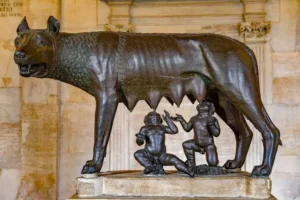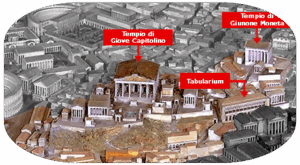Il Campidoglio, detto anche Monte Capitolino (Mons Capitolinus), è il più piccolo dei colli su cui venne fondata Roma.
Sul colle sorge il Palazzo Senatorio, sede del municipio della città eretto nel 1144.
Il termine inglese capitol (palazzo che ospita l’amministrazione di un governo), così come il termine capitale (inteso come città capitale), derivano dal Colle Capitolino.
La sua altitudine è di 48 m s.l.m. sull’Arx (attuale Basilica di S. Maria in Aracoeli), di 35,9 m s.l.m. nell’Asylum

(attuale Piazza del Campidoglio) e di 44,7 m s.l.m. sul Capitolium propriamente detto (Palazzo Caffarelli). Una sella, l’Asylum, divideva la sommità settentrionale (Arx) da quella meridionale (Capitolium propriamente detto), una cui propaggine, la Rupe Tarpea, era il luogo da dove venivano fatti precipitare i traditori. Nonostante la sua solida consistenza, il colle è composto essenzialmente da tufo, materiale largamente utilizzato dai romani per la costruzione degli edifici, come anche dimostrato dalla presenza di numerose gallerie sotto il colle, conseguenza dell’estrazione del materiale.
In epoca antica le pendici del colle rivolte verso il Tevere, il Velabro e la valle del Foro erano molto ripide, e per questo facilmente difendibili, mentre quelle verso Campo Marzio erano meno ripide, permettendo un più facile accesso alla sua sommità, anche per la presenza di una piccola sella che univa il Campidoglio con il colle del Quirinale, che fu tagliata solo in epoca imperiale da Traiano.

Il Campidoglio, per la sua conformazione fisica, e per la sua collocazione, con l’Aventino e il Palatino baluardo naturale dell’importantissimo guado sul Tevere, si rivelò fondamentale per la storia dell’Urbe sin dalle epoche più antiche.
Secondo la tradizione romana, il primo insediamento sul colle fu fondato dal dio Saturno (dove pure si trovava un tempio dedicato al dio), nel quale furono accolti i Greci guidati da Ercole. Il Campidoglio dovette essere abitato fin dall’età del bronzo, come provano alcune ceramiche scoperte ai piedi di esso, nell’area di Sant’Omobono e nello scavo presso il cosiddetto Giardino Romano.
Secondo lo storico Tacito il Campidoglio, come pure il sottostante Foro Romano, furono aggiunti alla Roma quadrata di Romolo da Tito Tazio. Altri lavori sul monte furono posti in essere dal quinto re di Roma, Tarquinio Prisco, il quale vi costruì l’ingresso trionfale. Il ritrovamento di un teschio durante i lavori della fabbrica del Campidoglio permisero all’indovino Caleno di predire che Roma sarebbe divenuta la prima città dell’universo.
Al Campidoglio è legato il racconto della presa della rocca ad opera dei Sabini che, guidati da Tito Tazio, attaccarono i Romani, per vendicarsi del Ratto delle sabine. Presa la rocca, grazie al tradimento di Tarpeia, i Sabini impegnarono i Romani in una guerra, che terminò solo grazie all’intervento delle donne sabine rapite, ormai spose e madri dei romani

The Capitoline Hill, also called Capitoline Hill (Mons Capitolinus), is the smallest of the hills on which Rome was founded.
On the hill stands the Palazzo Senatorio, the seat of the city’s municipality, built in 1144.
The English term capitol (building that houses the administration of a government), as well as the term capital (intended as capital city), derive from the Capitoline Hill.
Its altitude is 48 m above sea level on the Arx (now the Basilica of S. Maria in Aracoeli), 35.9 m above sea level in the Asylum
(now the Piazza del Campidoglio) and 44.7 m above sea level on the Capitolium proper (Palazzo Caffarelli).[4] A saddle, the Asylum, divided the northern summit (Arx) from the southern one (Capitolium proper), an offshoot of which, the Tarpeian Rock, was the place from which traitors were thrown. Despite its solid consistency, the hill is essentially composed of tuff, a material widely used by the Romans for the construction of buildings, as also demonstrated by the presence of numerous tunnels under the hill, a consequence of the extraction of the material.
In ancient times the slopes of the hill facing the Tiber, the Velabrum and the valley of the Forum were very steep, and therefore easily defended, while those towards the Campus Martius were less steep, allowing easier access to its summit, also due to the presence of a small saddle that joined the Capitoline Hill with the Quirinal Hill, which was cut only in the imperial era by Trajan.
The Capitoline Hill, due to its physical shape and its location, with the Aventine and the Palatine Hill, the natural bulwark of the very important ford on the Tiber, proved to be fundamental to the history of the city since the most ancient times.
According to Roman tradition, the first settlement on the hill was founded by the god Saturn (where there was also a temple dedicated to the god), in which the Greeks led by Hercules were welcomed. The Capitoline Hill must have been inhabited since the Bronze Age, as evidenced by some ceramics discovered at its foot, in the area of Sant’Omobono and in the excavation near the so-called Roman Garden.

According to the historian Tacitus, the Capitoline Hill, as well as the underlying Roman Forum, were added to the square Rome of Romulus by Titus Tatius. Other works on the hill were carried out by the fifth king of Rome, Tarquinius Priscus, who built the triumphal entrance there. The discovery of a skull during the construction of the Campidoglio allowed the soothsayer Calenus to predict that Rome would become the first city in the universe. The Campidoglio is linked to the story of the capture of the fortress by the Sabines who, led by Titus Tatius, attacked the Romans to take revenge for the Rape of the Sabine Women. Having taken the fortress, thanks to the betrayal of Tarpeia, the Sabines engaged the Romans in a war, which ended only thanks to the intervention of the kidnapped Sabine women, now wives and mothers of the Romans[12].